Altair: From Simulation and Optimization to Digital Innovation
With the ability to identify the latest technology megatrends, Altair has grown from a pure CAE and optimization software provider to a world-renowned simulation leader. Altair is relentless in its ability to develop new innovations, all while continuing to update and optimize its current solutions and provide its customers with cutting-edge software and cloud solutions in product development, high performance computing and data intelligence. It is Altair's understanding of technology and market changes, along with its persistent innovative spirit that make Altair an unshakable player in the industry today.
What has changed in Altair since the IPO? What progress has been made? How has Altair redefined itself after it entered the IoT and data science field? And what does James Scapa want to say to Chinese customers after five years?With all these questions, on July 12, 2019, Dr. Pei Huang, CEO of e-works, interviewed Mr. James Scapa, co-founder, chairman and CEO of Altair, and asked Mr. Scapa to share Altair's latest developments in design, simulation, IoT, data science and other fields.
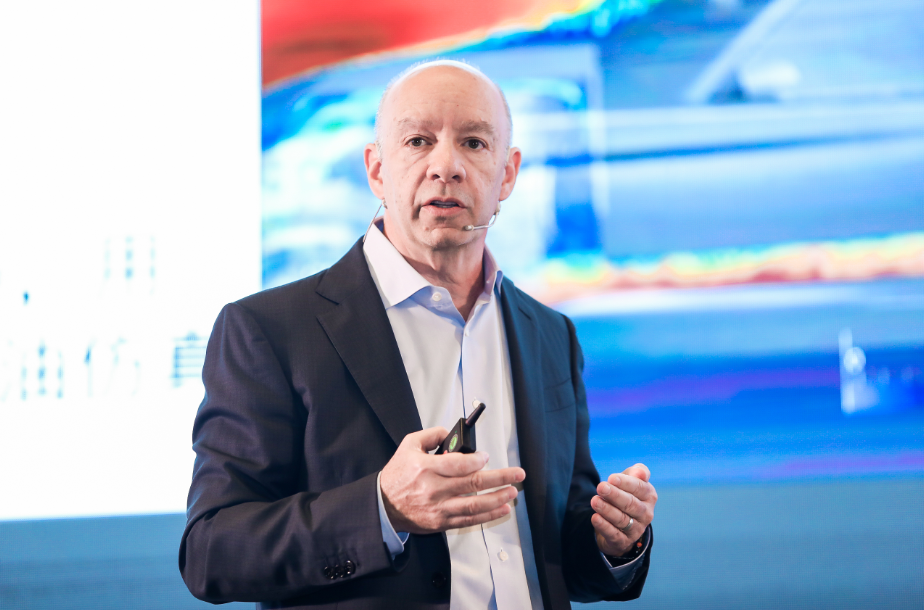
James R. Scapa, Co-Founder, Chairman and CEO of Altair
Pei Huang: It’s been one and a half years since Altair’s IPO in November 2017. Could you summarize the progress of Altair in product innovation and business development? I would like to know what’s new for Altair, what has been changed and what will not be changed.
James R. Scapa: One important advantage from the IPO for Altair is access to more capital. With that capital we are acquiring a lot of interesting technology companies. We still have an active pipeline of new technology solutions from our current portfolio, however, we are also seeing new opportunities in the areas of electronics and system modeling, as well as breakthrough innovations, like our recent SimSolid acquisition.
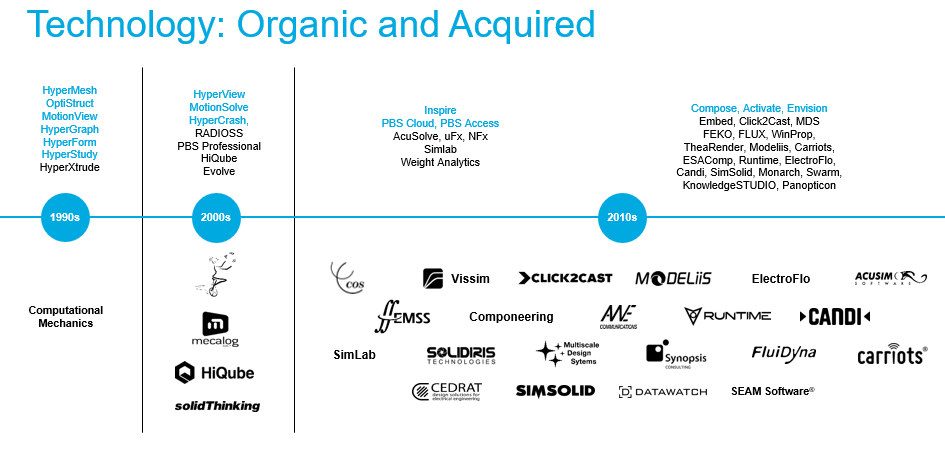
Altair’s self-developed products and acquisitions
What has not changed is the culture of the company. As a public company, external communication will be more thoughtful and deliberate. But inside the company, our culture is still very open and transparent.
Pei: Altair acquired SimSolid and Datawatch last year. Can you share some information about the acquisitions?
James: Regarding the SimSolid acquisition, in the beginning I didn't believe it because it looked like magic. I had one Altairian from our team in Austin, Texas evaluate it for me. He came back and he told me the SimSolid technology was amazing.
Since I'm on the board of visitors at Columbia University, I also had two notable professors at Columbia evaluate it and speak with the developer. One of the professors came back with a two-page e-mail stating there are very few people in the world with the level of mathematics skills as those held by the person who invented SimSolid. And combined with the practical engineering knowledge, the professor said SimSolid is going to change the world. So, we acquired it and brought it in to our product portfolio.
Anybody who is using CAD should be downloading SimSolid (https://www.altair.com/simsolid/). That's how truly revolutionary it is. To date, the entire market hasn’t realized the potential of SimSolid yet and we are not getting the level of attention it should.
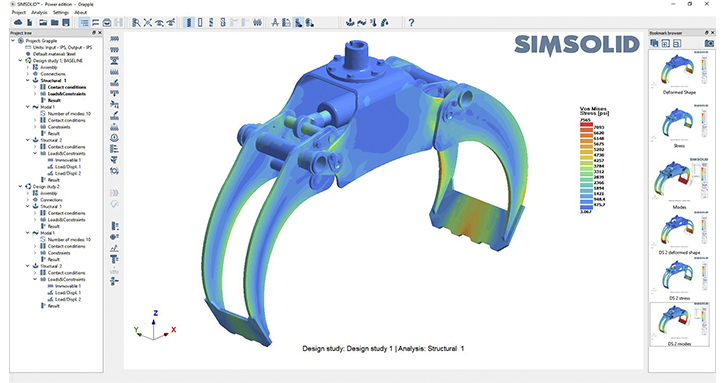
Altair SimSolid™
In finite element analysis we take a design and discretize it. And where there are connections, especially in assembly or boundary conditions and different loads, we make a lot of assumptions and add multi-point constraints. Often it's those assumptions that can cause mistakes. That's fine for high-end analysts doing simulation, but when you move to the designer community where they don't have PhDs in mechanical engineering, they're not going to make the right kinds of assumptions. With SimSolid, you don't need to make any assumptions. You simply import models and press the button to run. All the connections are automatically handled.
We have a lot of very high-end automotive customers who are beginning to realize, through the use of SimSolid, they have been modeling things incorrectly for many years. To me, this product is completely revolutionary. That's how important it is and why we invested in it.
As we see the future with artificial intelligence (AI) and machine learning exponentially growing, we made another big investment by acquiring a public company called Datawatch. There are a lot of start-ups doing AI, but I was excited about Datawatch because it had a more than 30 year history of applying machine learning. Additionally, it's a really deep company with 14,000 customers, 3,000 of which are significant in size.
Datawatch was an experienced company with great data scientists, mostly PhDs in mechanical engineering. This acquisition will allow us to converge our simulation technologies with the data intelligence tech from Datawatch, which combined will create significant opportunities for our customers.
Pei: Will SimSolid be one part of HyperWorks or will it be an independent product in your portfolio?
James: We have two options. You can access SimSolid by using HyperWorks Units, but you can get it as a stand-alone product as well. Additionally, we are putting SimSolid inside of the Altair Inspire product.
Pei: I realized that Altair has three CTOs. Can you tell me what the different roles of these three CTOs play?
James: I had one CTO who retired six years ago. When he retired, we had a discussion about whether Altair should still hire one CTO and we decided to divide things because we do so many different things in Altair.
James Dagg owns the user experience and desktop solutions. Uwe Schramm owns the physics solvers. And Sam Mahalingam is responsible for the enterprise technology, including cloud technology and data analytics. I'm also technical and work closely with all three.
One of our strengths is we communicate well together, and know when we are developing solutions, it now requires mixing different technologies to make that future solution.
Pei: Besides the CAE total solution, Altair also has data intelligence and IoT solutions. Right now the hottest buzzword in China is “IIoT”. There are very heavy investments and fundings from the government to support the companies to build new industrial internet platforms. In China there are more than six hundred industrial internet platforms. What do you think about that?
James: The way I think about the market is in phases. Some things we do today are profitable. Next is what we’ve invested in over the last five to ten years that are going to be profitable in the next five years. And then there are the investments, like IoT, that will have a return in the long-term future.
Over the last five years, we’ve been doing things in the IoT field before others realized it. We acquired a company in Madrid which had an IoT platform. They were doing a lot of projects in the telecom industry, as telecom technology is quite important in IoT. In parallel, we also acquired a company in San Francisco. Both companies had very little revenue. It was more about acqui-hire (hire the team through the acquisition) and, now, they're all part of one team today. Then we acquired Datawatch, which gave us the data science piece to add to real-time visualization. We now have the full solution, as well as new Altairians with deep expertise.
Over the last few years we’ve been doing some pretty cool projects we don't talk too much about. I think in the future we will not be the guys with the platform because Amazon, Microsoft and Alicloud will remain focused on platforms. What's important is knowing what to do once you have vast amounts of data. Some customers will be looking for a full solution. We have customers who are looking for our platform because we can do some interesting customization or we can leverage Microsoft to fit their needs. But what's more important is what our customers can do with data to make digital twins to optimize performance. That's where Altair has the expertise.
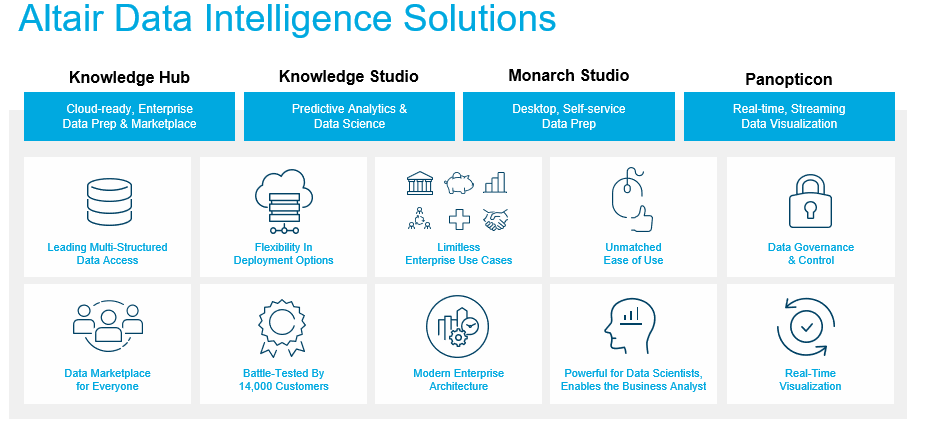
Altair’s Data Intelligence Solutions
Pei: I think, for example, if a very big machine is sold to the customer, it is very important to use IoT platform to monitor the operation and use the digital twin to simulate the possible problems So maybe you can introduce your view about digital twin and Altair's SmartWorks.
James: We see this idea of a unified digital twin. We have a solution called Altair Activate® for system modeling that we're leveraging to build digital twins. You can use Modelica to model physical devices, pumps, engines and motors. We also have blocks for electronics with SPICE (simulation program with integrated circuit emphasis).
So, you can model an entire system for a digital twin, either with just equations in the blocks, like 0D or 1D, or you can take out the simplified model and put a full-finite element of an electric motor, for example, in full 3D.
We will be launching a solution to allow our customers to develop these simulation digital twins. With the Datawatch technology and data coming from the physical devices, we see the ability to do data-driven digital twins. It's the linking of these data-driven digital twins and simulation-driven digital twins where we see the future headed. So that's where we're focused.
Pei: So after Altair entered IoT market and the data intelligence market, now I think it is not accurate to describe Altair as a global leading CAE company or simulation company. How do you define Altair?
James: Altair is a global technology company that provides software and cloud solutions in the areas of product development, high performance computing (HPC) and data intelligence. We enable organizations across broad segments to compete more effectively in a connected world while creating a more sustainable future.
Our vision is to transform product and business decision-making through simulation, data intelligence and optimization solutions.

Altair’s Comprehensive Software Solutions
Pei: So maybe some days that Altair will have a new product to simulate the stock price?
James: Maybe. But I think simulation technology will apply when you're looking at factory floor data. Now we're looking at stock price. But if you have factory floor data that's coming in real time, you're trying to see something interesting happening on the factory floor or with a device, even something wearable. It's those kinds of technologies that we're focused on.
Pei: Altair is an engineering company. I guess you're familiar with cooperating with banks. How is it going so far?
James: The day we announced the acquisition of Datawatch, our stock dropped 20 percent. The analysts call it “an orthogonal investment,” not in line with what we do. It can be difficult for people outside our world of technology to understand the importance of machine learning. Altair is a pretty unique company and part of it is because as a founder, I am still very involved. I'm strong and I don't stop pushing until we get where we need to go. We are making that transition in bringing together our core business with the data intelligence solutions from Datawatch.
One thing about Datawatch is it was not a very global company. Most of the business was in the U.S., some in the UK and Singapore. There were limited in terms of region and industries. We're trying to expand the golden market in Datawatch traditional markets which is financial services especially, but also some insurance companies, health care and retail. And then at the same time, go to our global engineering manufacturing customers, taking the technology across the engineering community. I think we're succeeding, but it takes time.
Pei: I think simulation and optimization driven innovation which proposed by Altair firstly has been widely accepted globally. Could you share something about optimization?
James: We got involved in optimization in the early nineties. Then we made the connection with a Japanese professor who invented the original topology technology. From there we evolved, as the way we work today is different from his original research. Altair has done so much original research in the last twenty years and are in a completely different league.
We began doing projects on individual components, but today every aircraft is designed using optimization where we design every layer of the layout: what the pattern is, what the orientation is, what the stacking sequences are. All the new composite structures are designed using abstract.
We're beginning to do interesting things using lattice designs, which I think is a little overstated by some. But there are some interesting applications where you can bury the compliances in different directions in these macro structures you're creating.
Almost everything in society today – like all the parts of the automobile, all the parts of airplanes and rail – are designed using optimization. When we first brought the technology to customers in the early days, they wondered what they should do with it. Today everyone is using it. But still by far, I think what we do is so sophisticated and leading edge, even with all manufacturing constraints.
Pei: About China market, I saw the graph that AP and EMEA and America each accounts for one third of the global market. So what's your view about China market?
James: I think it's going to continue to grow. The Chinese market has enormous potential.
Pei: Last time I also attended your ATC (Altair Technology Conference). So after five years, you attend this year's ATC again. What message do you want to tell the Chinese customer?
James: First of all, I want to show appreciation to our customers and thank them for their support. I want them to see that Altair is the strongest partner in the market for simulation, data science and high-performance computing.
I spoke with many customers yesterday and several told me at dinner they think we're by far the strongest company in the market. Some very senior people from our customers told me they really feel like we've passed the other companies. It’s because of their continued support and relationships we’ve built with them that drive us to continue providing unparalleled service and breakthrough solutions to help solve their toughest challenges.
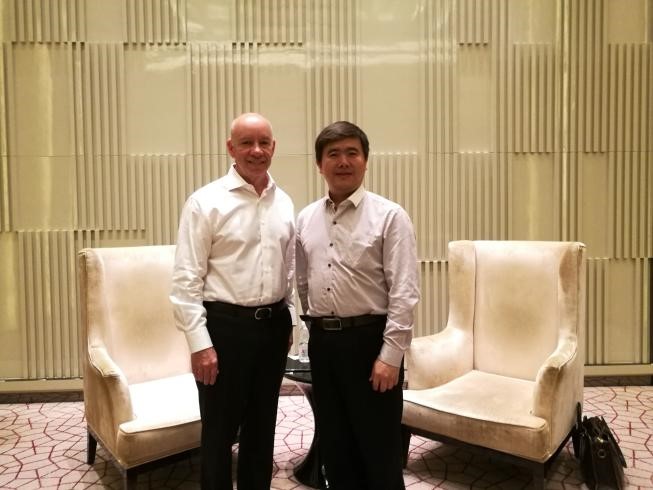
Left:James Scapa, Co-Founder, Chairman and CEO of Altair
Right:Dr. Pei Huang, CEO of e-works
Post Script: In recent years, China has become the largest market for Altair in the Asia-Pacific region. China's manufacturing industry is accelerating towards smart manufacturing. In this process, Altair not only keeps its performance growth in China, but also helps many independent R&D enterprises in China to improve their independent innovation capability.
Over the past 30 years, Altair has grown from a CAE tool provider to an international leading simulation giant and has earned its place in new areas such as the Internet of Things and data intelligence. With the continuous development and upgrading of the products of Altair, they are beginning to be more and more widely used in the market, in order to better assist the transformation and upgrading of manufacturing industry.








